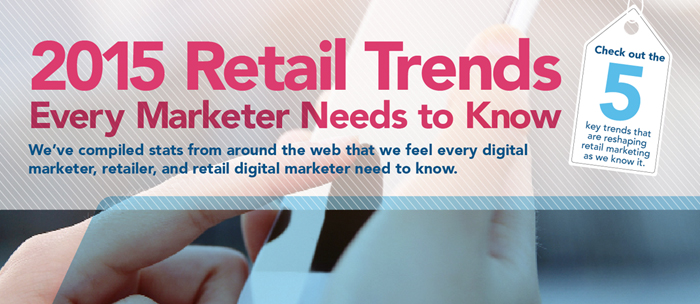
The all-important holiday season is around the corner, and retailers are looking for new ideas to maximize revenue this year. With that in mind, we wanted to share five programmatic trends that are improving retailer outcomes in 2015. We’ve visualized these in an infographic, which we encourage you to download. Consider it an early holiday gift from MediaMath!
Let’s run down the list, starting with those trends that are the most significant today:
- Digital now influences the majority of in-store sales. The lines are blurring between online and offline. Digital marketing impacts so much more than eCommerce sales alone. In fact, Deloitte estimates that 64% of all in-store sales will be influenced by digital in 2015. If that number sounds high, consider that 78% of digital shoppers in an Accenture study confessed to “webrooming,” meaning they shop online but purchase in-store. With CRM onboarding and multi-touch attribution in place, marketers can measure this online-to-offline impact.
- More than half of digital advertising in retail is now mobile. Mobile advertising is about more than reaching shoppers on phones and tablets. It is a powerful way to drive consumers down the purchase path with a cross-device and cross-channel strategy. Retailers often argue that while half their traffic is mobile, mobile does not drive half of their sales. This is not entirely true. If these retailers utilized cross-device, cross-channel attribution, they could see the impact mobile is having on their bottom line.
- Direct publisher deals are moving to programmatic. Fifty-nine percent of digital display spend in retail is still publisher direct. And three-quarters of these buys are not programmatic. They are done the old-fashioned way. But these relationships are migrating rapidly to programmatic. In 2015 alone, there will be almost 400% growth in Private Marketplace (PMP) deals. Why so dramatic? One key reason is the ability to layer first- and third-party data on publisher direct inventory. This results in better audience targeting and, therefore, better performance.
- Programmatic video is becoming a material part of digital ad spend in 2015. In fact, it will grow 204% this year. Once again, targeting is the main growth driver for this trend: 56% of ad execs cited targeting as the “most valuable digital video advertising feature for their clients.” As with TV, a large percentage of programmatic video spend is dedicated to branding. With multi-touch attribution in place, marketers can also measure the business impact of these upper-funnel tactics.
- Closed-Loop Attribution (CLA) is a logical next step for campaign optimization. With multi-touch attribution reporting, retailers can gain a solid understanding of how each media channel contributes to a purchase. But retailers typically want to go one step further. They want to use those results to inform media buying. With 15-20% of retailers now employing multi-channel attribution partners, and another 20-25% in the evaluation phase, CLA is becoming a hot topic. One client who recently implemented CLA saw a 21% improvement in ROAS on their campaigns.
Marketers have a lot to think about as the holiday shopping season barrels toward us. But every retailer should have a plan for at least one of the above trends. Make a list, and check it twice based on your financial goals and resources.
It is worth noting that multi-touch attribution is a key theme here. As retailers build out omnichannel strategies, the impact of every online and offline touchpoint should be measured if possible. To learn more, see MediaMath’s point of view on attribution analytics, and connect with us on your retail needs here.
